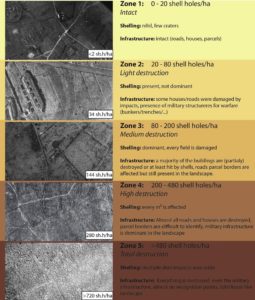
(Geoderma, 2018)
A new evaluation approach of World War One’s devastated front zone: A shell hole density map based on historical aerial photographs and validated by electromagnetic induction field measurements to link the metal shrapnel phenomenon
Since the end of World War One, only few research is performed to understand the extent of the destruction of the first meters of soil archive at the former Belgian front zone. The only existing sources identifying the by artillery destroyed landscape are maps indicating destruction at the level of administrative communities, based on war damage inventories. Even a century after the war, there is a need to gain more detail in the historical destruction at a landscape or parcel scale. Unlike in neighboring country France, the Belgian authorities allowed a complete repopulation of the front zone, which results in an ongoing confrontation between ground workers (farmers, construction workers, archaeologists, etc.), the war’s heritage (trenches, bunkers, graves, etc.) and its dangers (unexploded ordnances, UXO). Metal shrapnel and the high rate of unexploded shells (up to 30% of the fired projectiles) are typical remnants of this trench warfare. The localization of these phenomena is also useful to simulate the extent of the war’s environmental impact and the intensity of possible UXO-finds. To inventorize destruction and the related metal shrapnel pollution (MSP), we propose a new mapping method based on a sampling strategy to digitize shelling densities, derived from historical aerial photographs. This data source allows us to characterize almost every single parcel in this mainly agricultural area. By classifying the derived shelling densities, destruction classes can be distinguished to describe the impact on landscape and soil archive. The translation of the destruction map into a map indicating the level of buried metal shrapnel, was possible due to the direct relation between shells, metal shrapnel and shell holes. A validation with the buried metal objects was performed with metal parameters derived from electromagnetic induction field surveys. These scan results indicated a strong relation between shelling densities and the buried metal clutter. Based on the findings in this research, we offer tools to create an accurate destruction map that can be directly related to the occurrence of WW1 relicts within the soil archive.
Reference:
Note, N., Gheyle, W., Van den Berghe, H., Saey, T., Bourgeois, J., Van Eetvelde, V., Van Meirvenne, M., & Stichelbaut, B. (2018). A new evaluation approach of World War One’s devastated front zone: A shell hole density map based on historical aerial photographs and validated by electromagnetic induction field measurements to link the metal shrapnel phenomenon. Geoderma, 310 (Supplement C), 257-269.